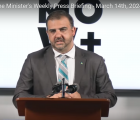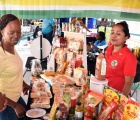(CARICOM Secretariat, Turkeyen, Greater Georgetown, Guyana) The CARICOM Election Observation Mission (CEOM) to Haiti has issued its Immediate Post-Election Statement in which it highlighted areas that could lead to “undesirable sequels” if not corrected.
Those areas included anomalies pertaining to voting norms, varying methodologies in poll practices and inadequate physical space at polling stations.
The eight-member team, headed by Dr. Steve Surujbally, Chairman of the Guyana Elections Commission, observed the 26 October Elections in Haiti. The team met with a number of persons including the Prime Minister, the Hon. Evans Paul, and representatives of the diplomatic corps in Haiti. The Mission visited 127 polling stations.
Read full statement below:
IMMEDIATE POST-ELECTION STATEMENT ON THE JUST CONCLUDED ELECTIONS IN THE REPUBLIC OF HAITI
The CARICOM Election Observation Mission (CEOM) comprised:
- Dr. Steve Surujbally, Chairman of the Guyana Elections Commission (Chief of Mission)
- Mr Ian Hughes, Registration Officer, Antigua & Barbuda Electoral Commission;
- Mr Geoffrey McPhee, Assistant to the Parliamentary Commissioner of The Bahamas;
- Mr Rudolph Waterman, Senior Executive Officer, Barbados Election Commission;
- Mr Henry George, Former Parliamentarian of Dominica;
- Mr Michael Flood, Commissioner, Electoral Commission of Saint Lucia;
- Mr Clement St Juste, Commissioner, Electoral Commission of Saint Lucia; and
- Ms. Neisha Ali-Harrynarine, Assistant Chief Election Officer (Ag), of Trinidad and Tobago.
The staff members from the CARICOM Secretariat who provided support to the Mission were Ms Tricia Barrow and Ms Denise London.
MEETINGS
During the periods before, during and immediately after Elections Day, meetings were held with:
- H.E. Hon. Prime Minister of Haiti, Mr. Evans Paul;
- The Hon. Minister delegate for Electoral Affairs, Mr. Jean Fritz Jean Louis;
- The General Coordinator of the National Council for Electoral Observation (CNO), Mr. Patrick Labb and his colleague Mr. Gédéon Paul;
- Member of the National Network for the Defense of Human Rights (RNDDH), Ms. M. Jean;
- The President of the Provisional Electoral Council (CEP), Mr. Pierre Louis Opont;
- The European Union’s officers stationed in Haiti, and members of the EU Observer Team;
- The Chef de Mission of the OAS Team and Members of the OAS Observer Mission;
- The Chef de Mission of PARLAMERICAS’ Elections Observer Term, Mr. Alain Gauthier;
Special Representative of the Secretary General of the United Nations (SRSG), H.E. Sandra Honoré; - Ambassadors of those countries within the European Union;
- The Ambassador of the United States to Haiti, Mr Peter F. Mulrean;
- The Ambassador of Canada to Haiti, Ms Paula Caldwell St-Onge;
- National Coordinator of the Haitian Council of Non State Organisations (CONAM), Mr. Edouard Paultre;
- The Group (including the Prime Minister, the Minister Responsible for Electoral Affairs and the President of the CEP) which attempted to launch the Non -Violence Pact and to which political parties were invited to adhere.
N.B. 1) Daily meetings with the CEOM members were convened for salient and in depth discussions.
CEOM ACTIVITIES ON ELECTIONS DAY
The CEOM was essentially deployed in four areas situated in and contiguous to the capital city Port-au-Prince. Plans for the CEOM to visit polling stations further afield had to be abandoned, under advice from the National Police.
The CEOM visited accumulatively 127 Polling Stations.
GENERAL OBSERVATIONS
The Team made the following General Observations which, if not corrected, could lead to undesirable sequels in the future:
1. Too many anomalies pertaining to voting norms exist (whether these were accidental or due to deficiencies in the training of the CEP cadre could not be ascertained).
N.B. It should be noted that the CEP does not recruit its own staff directly (e.g. via advertisement); rather, extraneous bodies (NGOs, political parties, Civil Society Organisations) propose candidates for selection.
2. Varying methodologies in the poll practices, on occasion, were used by CEP officers during the course of the day; for example, different fingers were stained as a form of identification. This would tend to reflect that the training of the CEP E-Day cadre either was not uniform, or that the CEP staff interpreted the processes differently despite common training.
3. The inadequacy of physical space in Polling Stations:
(a) led to the secrecy of the ballot being compromised (persons inside and outside of the Polling Stations could see for whom the voter was casting his/her ballot);
(b) could lead to the possible closure of a Polling Station, if it rained, since there were Polling Stations conducting business in the open air;
(c) led to the sauna-like conditions (not lastly in the tents) in which CEP Staff had to operate was in itself not conducive to efficiency, and on some occasions led to frayed nerves. However, at no time did the Team observe altercations between CEP officials and voters evolving into physical interactions. Nevertheless it was the considered opinion of the Team that five (5) Polling Stations in one room would obviously not be conducive to an optimal working environment;
(d) may have prompted the CEP to place scores of Polling Stations in one building. This led to some degree of turbulence at the entrance of the Polling Place Complex. The absence of trained, qualified and experienced ushers (information clerks/ ‘orienteurs’) exacerbated this problem; and
(e) led to a situation whereby party agents were too close to CEP staff thus on occasion intimidating the officers.
4. At the Tabulation Centre, there would be more transparency if the methodology of processing the Tally Sheets (not the content of the Tally Sheets) was shared with political parties and other important stakeholders.
5. It would help matters if, prior to the Elections, relevant laws were to be enacted, so as to assist any Electoral Court/Tribunal in carrying out its deliberations.
6. The Permanency of the Electoral Council would ensure that that critical body enjoys greater autonomy and authority in handling electoral matters, particularly as it pertains to political parties.
7. Lighting arrangements need to be improved.
CONCLUSIONS
Many more observations made by the CEOM on Elections Day will be documented in the Final Report. These in turn will be reflected in the recommendations contained in that document.
During the meetings with the stakeholders mentioned earlier, concerns were raised which paralleled the Team’s. However, these will be treated more expansively in the Final Report.
It would be remiss of the CARICOM Elections Observer Mission not to mention its appreciation for the very frank but cordial manner, with which the varied stakeholders, treated sensitive issues.
The CEOM felt that the inherent warmth, kindness and courtesy of the Haitian People were instrumental in making our sojourn, during this period of tenseness, very comfortable, and imbued us with the optimism and confidence that in spite of the unique challenges facing Haiti, electoral improvements can be guaranteed.
DR ROBERT STEPHEN SURUJBALLY
CHIEF OF MISSION
CARICOM ELECTION OBSERVATION MISSION
27 OCTOBER 2015





